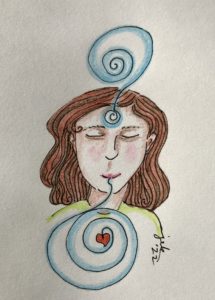
-Illustration © 2022 Jan Ketchel
Even somewhat polluted air is free, and it is Spirit. As Stan Grof, whose contributions I am currently immersed in, points out: in ancient Greek the word pneuma means both spirit and air. In Latin, spiritus means both breath and spirit. In Hebrew, ruach means both breath and creative spirit.
When we breathe we join our material, physical, animal body with our ephemeral spirit. Air is our ultimate soulmate. The simple act of breathing brings us communion with spirit.
The Christian Eucharist transfigures the materials of bread and wine into vehicles to merge with Spirit. It could certainly be argued that the effect of drinking wine and eating bread relaxes the tightened muscles in the body, allowing for an expansive breath and melding of social boundaries into greater oneness.
Wilhelm Reich’s greatest contribution to psychoanalysis was his concept of body armor, the tightened muscles of the body that house our traumas and vastly constrict the breath. In order to experience the fullness of release and spiritual wholeness of orgasm, one must discover what he called the orgasm reflex, which requires total freedom of breath and deep breathing to be activated.
Neuroscientists Daniel Siegel and Andrew Huberman stress the role of the breath for mental and physical health. Air reduces anxiety by simply binding with adrenalin and removing its effect upon the central nervous system. Mindful breathing calms an overly active spirited mind.
The shamans of ancient Mexico discovered the recapitulation breath, a bilateral movement of the head as one inhales to one side and exhales to the other. The benefits of bilateral movement to calm the amygdala and allow processing of traumatic experience was discovered in modern psychotherapy in the therapy of EMDR. In combination with the shamanic recapitulation breath, bilateral movement greatly enhances access to the innate holotropic healing potential activated at the subtle dimensions of our spirit being.
A seasoned practitioner of the recapitulation breath, used to activate a clinical soul retrieval, is my wife, Jan, whose journey is chronicled in her five-volume series The Recapitulation Diaries. I asked her to describe the details of her use of the breath for her dramatic holotropic healing.
Here’s what she said:
“I found the most benefit came when I did the recapitulation breath for an extended period of time. Often I would sit and breathe for over an hour, gently sweeping my head back and forth while sitting in a relaxed and supported pose, usually on my bed, with plenty of cushions to support my back. I found it suited me to have my eyes open, though many people keep their eyes closed. As I swept my head from side to side, breathing in and out, I kept my open eyes stationary in my head so that they too swept from side to side along with the movements of the head. This allowed for a softened gaze in which images appeared, memories that I could dive into and relive, seeing them as if they were movies playing before me, allowing me to process them and release them in whatever way I was ready for at the moment. I kept a journal beside me and was able to immediately jot down my experiences upon finishing the breathing pass. I suppose a phone, on ‘Record’, could also be used for this purpose, both during and after the experience, though I did not have that technology available to me at the time. My final breath was always a quick clearing breath, a swift sweeping of the head from side to side while holding my breath before releasing with a final, long exhale at the end of the session.”
Jack Schwarz introduced breathing patterns that give access to brainwave states associated with transpersonal dimensions of the psyche and promote the activation of holotropic healing. He emphasized allowing for deeper breathing through relaxing of the abdominal area, allowing for more air to enter the lungs.
Alpha brainwaves are reached by breathing in to a count of 8, holding for 8, and breathing out to a count of 8, followed by a holding of the breath for a count of 4 and then beginning again: 8-8-8-4. Theta brainwaves correspond to a 4-8-16-4 pattern. Delta corresponds to a 4-8-32-4 rhythm.
One should slowly work up to the longer held breath patterns and never push beyond what is comfortable. Simply breathing in and out with no holding restores the beta brainwave state of ordinary waking reality.
Accessing physical union with the spirit through the use of the breath is the essence of yoga with its pranayama breathing.
Air is indeed the ultimate miracle drug to promote the deepest healing and union of body and spirit. Most significantly, the fullness of breath opens us to the fullness of the physical life we are in, our deepest reason for being here, in this form, in this time.
Gently bring attention and intention to its healing balm. Become one with your airy soulmate.
In fellowship with all fellow breathers,
Chuck


